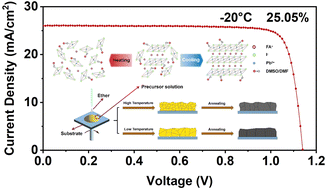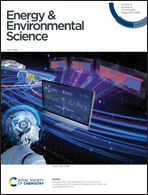“Freezing” intermediate phases for efficient and stable FAPbI3 perovskite solar cells†
Abstract
The most promising formamidinium lead triiodide (FAPbI3) has attracted extensive attention due to its record-breaking single-junction cell efficiency in perovskite solar cells (PSCs). However, the formation of α-FAPbI3 often requires δ-FAPbI3 as an intermediate phase, which suffers from low crystallinity and disordered crystal orientation, resulting in a high defect density in the final α-FAPbI3 phase. Herein, we report the synthesis of a stabilized and high crystallinity intermediate phase through full process (solution, anti-solvent, substrate, and processing atmosphere) low-temperature control. The low-temperature strategy allows the formation of larger and more stable colloids in the precursor solution for fewer but superior initial nuclei, and retards the film crystallization for better intermediate phase crystals. The defect density of the final perovskite thin film was reduced by 8 times. As a result, the efficient and stable FAPbI3 PSC was obtained with an efficiency of over 25% and a fill factor of over 85%, along with excellent long-term operating stability for 1000 hours under continuous light stress.



 Please wait while we load your content...
Please wait while we load your content...